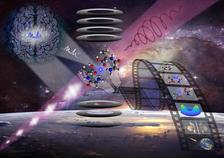Artistic impression of the project’s aim: With the help of artificial intelligence, ultrashort pulse structures of helical X-ray pulses are being characterised to realise new experimental possibilities on chiral molecules with FELs. (Image: DESY, Markus Ilchen)
A research collaboration led by Markus Ilchen and Sadia Bari (both DESY) and Swedish researchers Vitali Zhaunerchyk (Gothenburg University) and Mats Larsson (Stockholm University) has received approximately 1.5 million euros for four years in research funding from the Röntgen Ångström Cluster (RÅC), a Swedish-German science collaboration. The team will use the funding to use free-electron lasers to get closer to the mystery of nature's handedness and its dynamics on timescales of electron movements.
"All known life is made of chiral molecules," Markus Ilchen explains. Chiral molecules resemble each other like mirror images, but you cannot superpose the mirror image into the mirrored object by rotation. An example of this is our left and right hand. That is why this property is also called "handedness" - and pervades our everyday lives.
"Although today you can control and use chirality in many ways, there are fundamental chunks of knowledge missing," says Ilchen. "Using the latest developments at free-electron lasers (FELs), we can now access some of the fastest processes in nature to open up whole new research aspects for chirality. The infrastructure and the ambitious plans of the large-scale facilities in Hamburg, e.g. within the FLASH 2020+ developments make it an ideal place for our research plans.”
With the help of X-ray lasers such as the European XFEL, it should be possible to study individual molecules without having to crystallise them first. However, an imaging method does not allow for a comparable insight into the dynamics that are responsible for the bulk of the structural and thus also functional changes in molecules. For this, you have to look at all particles of a system precisely and with temporal resolution, including the electrons. This is the core of this research project, which the researchers want to approach in a large collaboration, e.g. with the CRC 1319 in Kassel and by employing artificial-intelligence analysis schemes.
The research team has set itself the goal of making better use of so-called photoelectron circular dichroism (PECD) at FELs through new instruments and sample preparation methods, in order to be able to take this step towards dynamics in chirality research. To do this, the researchers shoot a beam of circularly polarised photons – particles of light that also have a handedness – into a chiral molecular system and observe the behaviour of the electrons that are released from the interaction of the photons with the molecule. Initial FEL-based studies on chiral molecules have been carried out at LCLS and FLASH by the team, which now form a promising basis. The processes of interest range down to the attosecond range, i.e. less than a millionth of a billionth of a second, which corresponds to a femtosecond. "We want to observe how the electrons behave after excitation, which pathways they take and what this means for the structure and properties of chiral components of the molecule," explains Sadia Bari.
"I am very pleased that the promising but also very challenging work of our colleagues is getting a boost with the RÅC funding, and I am looking forward to seeing the results," says Edgar Weckert, DESY Director for Photon Science.
(from DESY News)







